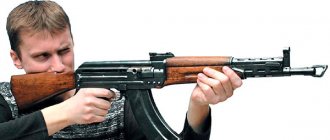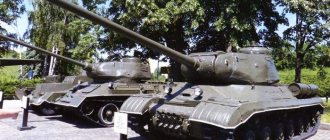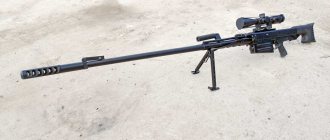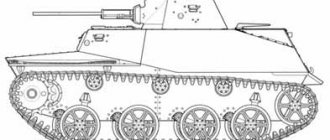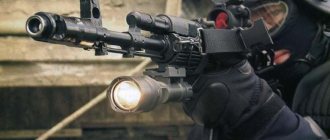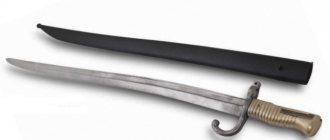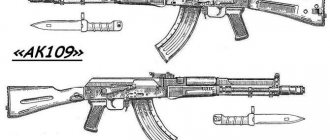Time passes, and even once successful weapon designs periodically cease to meet new standards. Often gunsmiths have to create new models, but often the problem can be solved by modifying existing models. The Kalashnikov system is over seventy years old. And all these years, machine guns, machine guns, and carbines based on AKs have not stopped being improved.
The latest generation of assault rifles, the AK-12, was demonstrated in 2012, and four years later, the most modern light machine gun, the RPK-16, appeared. It should replace previous modifications of the RPK-74 and, quite likely, will occupy a wider niche.
History of creation
Initially, the weapon complex created for the 7.62x39 mm cartridge included the Degtyarev light machine gun - a light, compact weapon with a belt feed. But, despite its excellent qualities, already in 1961 they began to replace it.
For the sake of maximum unification of all types of small arms, a new means of supporting the infantry squad was created on the basis of the AKM assault rifle. The RPK differed from the base model by a longer and heavier barrel, a modified butt, and a different sight.
Increased-capacity magazines were developed for the machine gun - a horn magazine for 40 rounds and a drum magazine for 75 rounds.
When the generation of small-caliber AK assault rifles appeared, the RPK-74 also became part of it. The creation of the AK-100 family led to the emergence of the RPK-201, an export version chambered for the NATO 5.56mm caliber cartridge. And the RPK-203 “returned” to the old 7.62mm cartridge.
But the evolution of the Kalashnikov light machine gun did not end there. In 2016, an initiative development by designers appeared - RPK-16.
Ammunition for the Kalashnikov light machine gun
The 7.62x39 cartridge is a universal ammunition developed in 1943 for automatic weapons. Most of the machine guns, machine guns and even automatic self-loading ones in the Russian army fire precisely these cartridges. Even some versions of civilian hunting weapons use this particular projectile. The cartridge can only compete with the unitary three-line ammunition of 7.62x39R caliber (model 1930) - used in the Kalashnikov tank machine gun and the Mosin rifle. However, today we will talk about the varieties of 7.62×39 mm:
- With an ordinary bullet with a steel core - the cheapest and most common type of ammunition, designed to defeat enemy personnel hiding behind easily shot through obstacles. Has no distinctive color.
- With a tracer bullet – used for zeroing a weapon or adjusting fire at a distance of up to 800 meters. Unlike the previous version of the ammunition, in this cartridge the bullet has a small glass of paint, which leaves behind a green tracer.
- With an armor-piercing incendiary bullet - the projectile is used to fire at lightly armored enemy vehicles at a distance of up to 300 meters. The core of the cartridge contains a glass with flammable liquid, and the tip is made of tombac. The ammunition is black and red in color.
And although the 7.62x39 mm cartridge does not have as many varieties as the unitary three-line projectile, it has gained great popularity among the military and hunters. The reason is simple - the increased muzzle velocity improves combat sharpness at a distance of up to 1000 meters. However, the projectile is designed specifically for firing from automatic weapons. The cartridge is not very suitable for bolt action rifles.
Machine gun design
The basic design of the RPK-16 remains the same. Powder gases are discharged through a hole in the barrel wall and act on a long-stroke piston. The barrel is locked by turning the bolt. And from the trunk, perhaps, we can begin to count the differences. He is now replaceable. Not quick-change, but it can be replaced by the shooter himself, in the field and without additional tools. The barrels are available in two options: short length – 415 mm, long – 580 mm.
The ability to install a short barrel will allow you to adapt the machine gun for urban combat. In its standard version, the RPK-16 is equipped with a muzzle brake-compensator. It is possible to install a low-noise firing device.
The sighting devices have been changed.
The machine gun's front sight was moved from the barrel to the gas outlet. The adjustable diopter rear sight has also moved from the front of the receiver to the rear. An additional protrusion has appeared on the fire mode switch for easier switching.
A folding stock for the RPK is nothing new. It appeared on the old RPKS, starting with the modification of the RPK-74M machine gun, and is installed as standard. But now the butt is adjustable and ergonomic. The pistol grip has also become ergonomic. It has a built-in pencil case in which you can store weapons care accessories.
The dovetail mount is a thing of the past - the RPK-16 receiver comes standard with a Picatinny rail - a universal mount that allows you to quickly install any sights on the machine gun. For installation of additional accessories such as combat lights or laser designators, additional attachment points are provided on the forend.
Compared to the era when machine guns, adapted for mounting night sights, came in separate modifications, this is an unconditional step forward. The thickness of the walls of the receiver has been increased - even for the AK of the hundredth series it was 1 mm, for the RPK-16 it was 1.5 mm. The receiver cover received rigid fastenings at two points.
The presence of the already mentioned safety switch indicates that the RPK-16 is not unified with the AK-12 in terms of controls. It also lacks a bolt stop mechanism.
Despite the desire expressed by the Russian Ministry of Internal Affairs to have a light machine gun with combined power supply, the RPK-16 remained completely “magazine-fired”.
It can use regular 30-round magazines from the AK-74, or extended magazines for the RPK-74. Just in case this is not enough, the designers have prepared a new drum magazine with a capacity of 96 rounds.
At the moment, the machine gun exists only in 5.45x39 mm caliber. Modern armor-piercing bullets of this cartridge can penetrate body armor of the third class of protection. Probably in the future they will present an export NATO caliber machine gun and a variant chambered for a more powerful 7.62x39 mm cartridge.
Advantages and disadvantages of the model
A few words about the positive and negative sides of the model, because each weapon has not only pros, but also cons. For ease of reference, we have placed it in a small table:
Advantages and disadvantages
Simplified production technology - the cost of weapons has decreased significantly.
The universal cartridge 7.62 has a huge number of varieties (armor-piercing, tracer, etc.).
Quite light weight for a machine gun (only 1-1.5 kg more than an AK) - the model can be used by infantrymen.
Good penetration ability combined with combat accuracy is second only to modern models.
Limited upgrade - the machine gun does not support the installation of a body kit (except for night vision devices).
A meager number of modifications and design options - the versions differ mainly in the kit.
Low sighting range when using a standard rear sight (for the PKT this figure is 1.5 km).
There is no possibility of installation on a tank (a separate PKT model has been developed for this).
So do the positives outweigh the negatives? Absolutely yes. Just a few decades ago, you would hardly have been able to find any flaws in the PKK at all. However, in comparison with modern analogues entering service with the armies of the Russian Federation and Europe, the Kalashnikov light machine gun no longer seems to be an outstanding rifle unit. Although it is not for nothing that it is in service in many countries of the Middle East and Africa.
Performance characteristics in comparison with enemy analogues
Let's compare the main parameters of the RPK-16 and its analogues. These include the widespread FN Minimi light machine gun and the M27 rifle, which replaced light machine guns in the US Marine Corps. The data given refers to the RPK-16 with a short barrel.
| RPK-16 | FN Minimi | M27 IAR | |
| Caliber, mm | 5.45 | 5.56 | 5.56 |
| Weight, kg | 4.5 | 6.85 | 4.4 |
| Barrel length, mm | 415 | 465 | 420 |
| Magazine (tape) capacity, cartridges | 45 | 100-200 | 30 |
| Rate of fire, rounds per minute | 700 | 700-1150 | 700-1150 |
Of course, the RPK-16 outperforms its main rival in terms of weight. On the other hand, the Minimi is a “real” machine gun, belt-fed, heavy, quick-change barrel, firing from an open bolt. It also includes a rate of fire regulator. But the M27 seems to be a direct analogue of the RPK. In fact, this is a variant of the German HK416 assault rifle, which was supposed to replace the “automatic squad weapon” M249 (the same Minimi). As a result, as of 2022, they also replaced standard M4A1 carbines.
The M27 was criticized for the fact that a standard 30-round magazine would not be able to provide sufficiently dense fire. It is fair to make the same claim against the RPK-16. Of course, the designers stated a 96-round magazine, but such magazines usually turn out to be bulky and unreliable. Both Russia and the USA developed four-row magazines with a capacity of 60 rounds (6L31, MAG5-60), but they were not accepted for service.
It is significant that a machine gun with combined power supply was created in the USSR back in the 70s, but was never brought to an acceptable level. And Minimi can use standard automatic magazines, but it is recommended to resort to this only in emergency cases - it is believed that this reduces reliability.
It is worth mentioning that during the second half of the 20th century, attempts to create a light machine gun based on a standard machine gun were usually not successful.
The Belgian FN FALO was not popular. American efforts to develop machine guns based on the M14 and M16 rifles came to nothing. The British L86 turned out to be a terrible machine gun, but a good sniper rifle. Finally, the Italian AS 70/90 remained produced in a small experimental series.
Only the PKK was destined for relatively wide distribution and a long life. Although its spread is largely due to the supply of weapons to countries supported by the USSR. At the same time, the “outdated” RPD during, for example, African wars, was often valued more highly.
It is easy to see that the main and undeniable innovation in the design of the RPK-16 is the ability to change the barrel. But stocks and Picatinny rails are replaceable accessories. But no one will claim that they created a new model of an assault rifle by installing a fore-end and stock made by, for example, Magpul on an old AKM. Of course, the Kalashnikov concern’s desire to bring existing systems to modern standards is commendable. On the other hand, the RPK-16 in some ways even represents a step back compared to the AK-12.
In 2022, the RPK-16 entered military testing.
In February 2022, TASS reported that the Ministry of Defense had signed a contract for the supply of machine guns. As already noted, store-bought food can seriously limit the PKK's capabilities as a support weapon. And if a large-capacity magazine turns out to be convenient and reliable, it is unclear what could prevent them from being used with lighter AK-12s.
In fact, the short-barreled RPK-16 will be fundamentally different from the AK-12 with a drum magazine only in greater mass, the notorious possibility of changing the barrel and the lack of unification in some components. It is likely that American history will repeat itself, when the M27, adopted as a support weapon, eventually became the main weapon of the Marines.
It is difficult to say whether the Kalashnikovites counted on the prospect of such “intraspecific competition.” In the end, time will tell what place the RPK-16 is destined to take.
Photo RPK-74
RPK-203 - export version chambered for 7.62x39 mm
RPK-74MN with night sight NSPU-3
Similar
AK-47 assault rifle cartridge caliber 7.62 mm.
Device. Rate of fire AK-74 assault rifle cartridge 5.45 mm caliber. Device. Rate of fire
Dragunov SVD sniper rifle caliber 7.62 mm. Device
AKS-74U assault rifle cartridge caliber 5.45 mm. Device. Weight
Mauser K96 pistol cartridge caliber 7.63 and 9 mm. Device
Pistol Walter PP / PPK cartridge caliber 7.65 and 9 mm. Device
Pistol Yarygin PYa Grach cartridge caliber 9 mm. Device
DShK machine gun cartridge caliber 12.7 mm. Device. Rate of fire
Luger pistol R.08 Parabellum cartridge caliber 9 mm. Device
Pistol PM cartridge caliber 9 mm. Rate of fire. Dimensions. Bullet speed. Sighting range
Self-loading shotgun Saiga-12 cartridge, caliber. Device
Maxim machine gun cartridge caliber 7.62 mm. Device. Weight
PPSh-41 Shpagina submachine gun cartridge caliber 7.62 mm
APS Stechkin pistol cartridge caliber 9 mm. Device
Nagan system revolver cartridge caliber 7.62 mm. Device
Kalashnikov PK machine gun and PKM cartridge caliber 7.62 mm. Device
Simonov carbine SKS-45 cartridge caliber 7.62 mm. Device
Rifles and carbines Mauser 98 caliber 7.92 mm. Device
PPS-42 and PPS-43 Sudaev submachine gun cartridge caliber 7.62 mm
Pistol Walter P38 cartridge caliber 9 mm. Device
MP-40 German submachine gun cartridge caliber 9 mm. Device
VSS Vintorez sniper rifle caliber 9 mm. Device
Submachine gun PP-91 Kedr cartridge 9 mm caliber. Device
Light machine gun RPK-74 cartridge caliber 5.45 mm. Device
Pistol Glock 17 cartridge caliber 9 mm. Device
Makarych, Izh-79-9T, MR-79-9TM, MP-80-13T traumatic pistol
AK-12 assault rifle cartridge caliber 5.45 mm. Device. Weight
Mosin rifles and carbines Three-line caliber 7.62 mm
PMM Makarov pistol modernized 12 rounds. Device
Revolver Colt Single Action Army (SAA) Peacemaker. Device
Machine gun PKP Pecheneg cartridge caliber 7.62 mm. Device
Sniper rifle VSSK Exhaust caliber 12.7 mm. Device
Beretta pistol 92 cartridge caliber 9 mm. Device
TT - Tokarev pistol cartridge caliber 7.62 mm. Device
Submachine gun PP-19 Bison cartridge caliber 9 and 7.62 mm. Device
Sniper rifle SV-98 caliber 7.62 mm. Device
Vladimirov KPV machine gun cartridge caliber 14.5 mm. Device
ASH-12 assault rifle cartridge caliber 12.7 mm. Device. Rate of fire
PSM pistol cartridge caliber 5.45 mm. Device
Pistol Colt M1911A1 cartridge caliber 45. Device
Smith-Wesson revolver Russian cartridge, caliber 10.67 mm. Device
Degtyarev DP-27 light machine gun, 7.62 mm caliber cartridge. Device
Shotgun Mossberg 500 Cartridge. Dimensions. Rate of fire. Sighting range
Thompson submachine gun cartridge caliber 11.43 mm. Device
Pistol USP Heckler und Koch cartridge, caliber. Device
Hunting carbine OSK-88 (SVT-40) caliber 7.62 mm. Device
AS Val silent automatic cartridge caliber 9 mm. Device
Submachine gun PP-19-01 Vityaz cartridge 9 mm caliber. Device
Machine gun Kord cartridge caliber 12.7 mm. Device. Weight. Sighting range
Osa - traumatic pistol cartridge, caliber. Device
AK-9 assault rifle cartridge caliber 9 mm. Device. Rate of fire
Degtyarev RPD light machine gun, 7.62 mm caliber cartridge. Device
Automatic OTs-14 Groza cartridge caliber 9 mm and 7.62 mm. Device
Czech pistol CZ-75 (modifications). Device
Browning pistol 1903 cartridge caliber 9 mm. Device
Sniper rifle OSV-96 caliber 12.7 mm. Device
FN P90 submachine gun cartridge caliber 5.7 mm. Device
Submachine gun OTs-02 Cypress cartridge caliber 9 mm. Device
Sniper rifle ASVK Kord caliber 12.7 mm. Device
Automatic AEK-971 Cartridge. Caliber. Device. Rate of fire
Steyr AUG assault rifle (A1, A2, A3) cartridge caliber 5.56 mm
AK series 100 assault rifles. Modifications. Device. Weight. Dimensions
Uzi submachine gun. Cartridge. Caliber. Rate of fire
Pistol SR1M Gyurza cartridge caliber 9 mm. Device
Pistol GSh-18 cartridge caliber 9 mm. Device
SVDK sniper rifle caliber 9.3 mm. Device
Automatic SR-3M Whirlwind cartridge caliber 9 mm. Device
Machine gun NSV-12.7 Utes cartridge, cal. Device. Weight
Kalashnikov RPK light machine gun cartridge caliber 7.62 mm. Device
Sniper rifle VSK-94 caliber 9 mm. Device
Vostok-1 (Jorge-3M) 9mm caliber traumatic pistol. Device
Degtyarev PPD submachine gun cartridge caliber 7.62 mm
English sniper rifle L96A1 cartridge, caliber
M1 Garand rifle cartridge caliber 7.62 mm. Device
Desert Eagle pistol. Device
Smith-Wesson revolver (modifications). Device
Automatic rifle HK G36 (E, K, C, KE) cartridge caliber 5.56 mm
Pistol P-96 cartridge caliber 9 mm. Device. Rate of fire
Pistol GP35 Browning High Power cartridge, caliber. Device
Assault rifle FN SCAR (L, H) cartridge caliber 5.56 and 7.62 mm
Revolver Lefoshe M1856 cartridge caliber 11 mm. Device
Submachine gun PP-90 cartridge caliber 9 mm. Device
AN-94 Abakan automatic Nikonov cartridge caliber 5.45 mm. Device
Submachine gun PP-2000 cartridge caliber 9 mm. Device
Mauser pistol HSc cartridge caliber 7.65 and 9 mm. Device
M16 automatic rifle cartridge caliber 5.56 mm. Device
Fedorov assault rifle cartridge caliber 6.5 mm. Device. Rate of fire
Pistol Baltiets cartridge caliber 7.62 mm. Device
Strizh pistol cartridge caliber 9 mm. Device. Weight. Sighting range
Browning pistol 1910 cartridge caliber 7.65 and 9 mm
Silent pistol PSS Vul cartridge caliber 7.62 mm. Device
Pistol SIG-Sauer P226 cartridge caliber 9 mm. Device
Pistol OTs-27 Berdysh cartridge caliber 7.62 mm and 9 mm. Device
AK-107 assault rifle cartridge caliber 5.45 mm. Device. Rate of fire
OTs-44 sniper rifle, caliber 12.7 mm. Device
German machine gun MG3 cartridge caliber 7.62 mm. Device
Self-loading shotgun Browning Auto-5 cartridge, caliber. Device
Submachine gun AEK-919K Kashtan cartridge caliber 9 mm. Device
PB pistol silent cartridge 9 mm caliber. Device
Pistol OTs-33 Pernach cartridge caliber 9 mm. Device
Hunting carbine KO-98 cartridge caliber 7.92 mm. Device
TK (Korovin pistol) caliber 6.35 mm. Device. Weight. Dimensions
Underwater assault rifle APS cartridge caliber 5.66 mm. Device
Pistol OTs-21 Malysh cartridge caliber 9 mm. Device
American M60 machine gun, 7.62 mm caliber cartridge. Device
MTs-116M sniper rifle, caliber 7.62 mm. Device
Automatic 9A-91 cartridge caliber 9 mm. Device. Rate of fire
Submachine gun PP-93 cartridge caliber 9 mm. Device
VAG-73 - Gerasimenko pistol. Device. Weight. Dimensions
Cordon-5 is a traumatic pistol. Device. Weight. Dimensions
Goryunov SG-43 heavy machine gun cartridge caliber 7.62 mm. Device
Webley revolver cartridge, caliber. Device. Dimensions. Weight
Machine gun AEK-999 Badger cartridge caliber 7.62 mm. Device
RP-46 machine gun, 7.62 mm caliber cartridge. Device. Rate of fire
Sniper rifle VS-8 cartridge caliber 8.6 mm. Device
Slostin machine gun cartridge caliber 7.62 mm and 14.5 mm. Device
Assault rifle Tavor TAR-21 cartridge caliber 5.56 and 5.45 mm
Submachine gun SR-2 Veresk cartridge caliber 9 mm. Device
Lancaster pistol cartridge caliber 12.1 mm. Device. Rate of fire
Submachine gun PP-90M1 cartridge caliber 9 mm. Device
Underwater pistol SPP-1M. Device. Weight. Dimensions
Traumatic pistol MP-461 Guard. Device. Weight. Dimensions
Lebel rifles and carbines are cartridgeed in 8 mm caliber. Device
Automatic A-91 cartridge caliber 7.62 mm. Device. Rate of fire
M14 automatic rifle cartridge caliber 7.62 mm. Device
Revolver Smith & Wesson Model 10 Military & Police
Automatic rifle FN FAL cartridge caliber 7.62 mm. Device
Submachine gun STEN MK 2. Device. Weight. Dimensions
Traumatic pistol IZH-78-9T Chain mail cartridge caliber 9 mm
Leader-M traumatic pistol 11.43×32T. Device. Weight. Dimensions
Ingram M10 and M11 submachine gun. Device. Weight. Dimensions
Pistol Steyr M9-A1 cartridge caliber 9 mm. Device. Weight
Pistol OTs-23 Dart cartridge caliber 5.45 mm. Device
Berthier rifles and carbines caliber 8 mm. Device
Automatic shotgun USAS-12 cartridge caliber 18.5 mm
Sniper rifle VS-121 caliber 7.62 mm. Device
Traumatic pistol MP-353 cartridge, caliber 11.43 mm
Tiss machine gun cartridge caliber 9 mm. Device. Rate of fire
Traumatic pistol MP-355 cartridge caliber 9 mm. Device
Automatic double-medium ADS cartridge caliber 5.45 mm. Device. Rate of fire
Traumatic pistol MP-81 cartridge caliber 9 mm. Device
Pistols Zastava 70 and 70(k), cartridge caliber 7.65 or 9 mm. Yugoslavia
Sniper rifle GALATZ (Galil) cartridge caliber 7.62 mm
Pistol MP-444 Bagheera cartridge caliber 9 mm. Device
Revolver Colt New Army / Navy. Device. Bullet speed. Sighting range
Type 64 is a Japanese automatic rifle. Device
Differences from AKM
The AKM assault rifle became the basis for the RPK, because the machine gun had the following design configurations:
- to increase the initial bullet speed to 745 m/s, the barrel was lengthened;
- the receiver liner was strengthened;
- the weight of the barrel has been increased to ensure an intense fire regime compared to the AKM;
- to ensure stability when firing, the machine gun was equipped with a lightweight folding bipod;
- to increase the combat rate of fire, the capacity of the machine gun magazine has been increased: up to 40 rounds – sector, up to 75 rounds – disc;
- the butt was made in the shape of the butt of a Degtyarev machine gun to ensure ease of shooting;
- The sight was equipped with a fully movable one, so that the impact of external conditions on shooting accuracy could be taken into account.
Prospects for further modernization of PCM
Most information about the development of a new machine gun based on PKM and Pecheneg is classified. However, it became known that the designers of the Degtyarev arms factory focused on reducing the weight and dimensions of the machine gun and improving its ergonomics.
Based on the technical specifications of the Ministry of Defense of the Russian Federation, the product was brought to serial production within 4 years.
For the first time, titanium was used to make machine gun parts.
The barrel was made with ribs and forced cooling, but without a casing. To be able to use the 1P89-3 optical sight, a Picatinny rail was installed.
The buttstock became folding and telescopic. Added tactical grip.
For the needs of special forces, the barrel was shortened and equipped with an attachment for silent and flameless shooting. Under the name "Badger" it received the highest praise from the fighters of these units.
The bipod of the new product can be easily removed and can be mounted on the end of the barrel or on the gas chamber.
Testing of new samples was carried out in special chambers simulating different climatic conditions. Reliability is guaranteed in the temperature range from -50° to +50°. Tests with increased charge and increased pressure are also used.
Accuracy parameters are checked only with single shots.
When delivering large quantities, one randomly selected product from the batch is subjected to comprehensive testing.
As journalists found out, the plant’s design bureau is now engaged in establishing the production of machine guns for local conflicts, and in parallel, the construction of robotic combat systems, such as, for example, Nerekhta, is underway.
Possible delays and malfunctions that occur during shooting and ways to eliminate them
| Delays and their characteristics | Reasons for delays | Remedies |
| 1. The bolt frame does not move to the forward position. The bolt frame stopped before reaching the forward position, another cartridge was in the chamber, and the extractor hooks did not capture the cartridge in the receiver. | 1. Contamination of the receiver or chamber, carbon deposits in the gas chamber pipe. 2. The cartridge or tape is dented or dirty. | -Without disassembling the machine gun, lubricate the chamber, rubbing parts, and gas chamber pipe. At the first opportunity, clean the machine gun or replace the barrel. -Replace cartridges or tape. |
| 2. Misfire. The bolt carrier is in the forward position, the cartridge is in the chamber, the shot did not occur. | 1.Chuck malfunction. 2. Malfunction of the drummer. 3. The machine gun is dirty or the lubricant has hardened. | + inspect the cartridge removed from the chamber and, if there is no deep dent on the primer, clean the bolt, chamber and rubbing parts, and if the firing pin breaks or wears out, send the machine gun to a repair shop. |
| 3. Failure to remove the cartridge case. The bolt frame stopped in an intermediate position, the cartridge case remained in the chamber, and the next cartridge buried a bullet in it. | 1. Malfunction of the ejector or its spring. 2. Contamination of the chamber or cartridge, failure of the rim of the sleeve. | 1. If the cartridge case cannot be removed from the chamber during reloading, knock it out with a cleaning rod or replace the barrel. 2. if the rim of the cartridge case breaks, clean the chamber, lubricate the cartridges in the tape and move the regulator to a lower division. 3. If the ejector or its spring is faulty, send the machine gun to a repair shop. |
| 4. Sticking of the sleeve. The cartridge case removed from the chamber remains in the receiver or is pinched in its window by the bolt. | 1. Contamination of rubbing parts, gas paths or chamber. 2. Malfunction of the reflective protrusion or flap pusher. 3. Malfunction of the ejector or its spring. | 1.Remove the cartridge case from the receiver and continue shooting. If the delay is repeated, lubricate the rubbing parts and the chamber. 2. If the ejector, its spring, reflective protrusion or shield pusher are faulty, send the machine gun to a repair shop. |
| 5. Transverse rupture of the sleeve. The bolt frame did not reach the forward position, since the front part of the ruptured cartridge case remained in the chamber and did not allow the chambered cartridge to enter it. | 1. Large gap between the breech end of the barrel and the bolt. 2.Chuck malfunction | If, when reloading a machine gun, the ejected cartridge removes the front part of the cartridge case, continue shooting. If the front of the case remains in the chamber, remove it using a case extractor or replace the barrel. To remove the front part of the cartridge case, you need to unload the machine gun, insert the extractor into the chamber, uncock the bolt frame and forcefully pull it back. When the delay is repeated, move the barrel back, to do this, knock out the pin of the barrel lock screw, unscrew the screw one turn with a screwdriver and insert the pin. |
| 6.Incomplete retraction of the bolt frame. The bolt frame stopped in an intermediate position, the cartridge removed from the receiver remained in the extractor hooks. | 1. Contamination of rubbing parts. 2. Jamming of the tape in the cartridge box. The tape is skewed in the receiver. | - cock the bolt frame using the reloading handle and continue firing. When repeating the delay, after unloading the machine gun, inspect the placement and correctness of the tape. If the tape is laid and equipped correctly, move the regulator to a larger division. - Clean and lubricate the machine gun as soon as possible. |
| 7. Involuntary shooting. When the electric trigger button or trigger lever is released, shooting does not stop. | 1. Malfunction of the trigger mechanism. 2. Rounding of the bolt frame cocking. 3. Contamination of the machine gun, hardening of the lubricant. | -Stop shooting by pressing the tape against the receiver with your hand. Unload the machine gun, inspect the sear and combat platoon. if they are in good condition, move the regulator to a larger division and lubricate the rubbing parts. |
| 8.Do not catch or lose the cartridge with the extractor hooks. The bolt carrier has stopped in the forward or intermediate position. | 1. Malfunction of the extractor hooks. 2. Settlement of the feed finger spring or upper finger spring. | -Remove the cartridge case from the chamber or receiver. Load the machine gun and continue shooting. - when repeating the delay, inspect the extractor hooks and the springs of the feed finger and upper fingers. If they are faulty, send the machine gun to a repair shop. |
